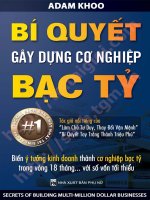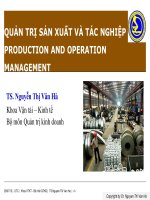chapter 1
Bạn đang xem bản rút gọn của tài liệu. Xem và tải ngay bản đầy đủ của tài liệu tại đây (1.82 MB, 57 trang )
Text: Historical Geology
Evolution of Earth and Life Through Time
4th edition
by Wicander and Monroe
Chapter 1
The Dynamic and
Evolving Earth
The Movie of Earth’s History
• What kind of movie would we see
– if it were possible to travel back in time
– and film Earth’s History
– from its beginning 4.6 billion years ago?
• It would certainly be a story of epic
proportions
–
–
–
–
with great special effect
and a cast of trillions
twists and turns in its plot
with an unknown ending
• Although we cannot travel back in time,
– the Earth’s History is still preserved
– in the geologic record
Subplot: Landscape History
• In this movie we would see
–
–
–
–
–
a planet undergoing remarkable change as
continents moved about
ocean basins opened
mountain ranges grew along continental margins
and where continents collided
–
–
–
–
form and grow
change circulation patterns
cause massive ice sheets to form and grow
and then melt away
• The oceans and atmosphere would
• Extensive swamps or vast interior deserts
– would sweep across the landscape
Subplot: Life’s History
• We would also witness
– the first living cells evolving
– from a primordial organic soup
– between 4.6 and 3.6 billion years ago
• Cell nuclei would evolve,
– then multicelled soft-bodied animals
– followed by animals with skeletons and then
backbones
• The barren landscape would come to life as
– plants and animals moved from their watery home
– insects, amphibians, reptiles, birds and mammals
– would eventually evolve
Earth is a Dynamic and
Evolving Planet
• Changes in its surface
• Changes in life
At the End of the Movie
• The movie’s final image is of Earth,
– a shimmering blue-green oasis
– in the black void of space
– and a voice says,
• “To be continued.”
The Movie’s Theme
• Every good movie has a theme,
– and “The History of Earth” is no exception
• Three interrelated themes run throughout it
• The first is that Earth’s outermost part
– is composed of a series of moving plates
• Plate tectonics
– whose interactions have affected its physical and
biological history
• The second is that Earth’s biota
– has evolved or changed throughout its history
• organic evolution
Earth is a System of
Interconnected Subsystems
•
•
•
•
•
Atmosphere (air and gases)
Hydrosphere (water and oceans)
Biosphere (plants and animals)
Lithosphere (Earth’s rocky surface)
Interior (mantle and core)
Interactions in Earth’s
Subsystems
re
e
h
p
s
o
e
r
m
e
t
h
A
p
s
Bio
Gases from
respiration
Transport
of seeds and
spores
Interactions in Earth’s
Subsystems
mo
t
A
re
e
sp h
h
t
i
L
Wind erosion, transport
of water vapor for
precipitation
re
e
h
p
s
o
Mountains
divert air
movements
Interactions in Earth’s
Subsystems
Source of sediment
Hyd
and
dissolved
rosp
here
material
Lith
os
phe
re
Water
and glacial
erosion, solution
of minerals
This class is about historical geology
What is Geology?
• From the Greek
– geo (Earth) logos (reason)
• Geology is the study of Earth
• Physical geology studies Earth materials,
– such as minerals and rocks
– as well as the processes operating within
– and on Earth’s surface
Historical Geology
• In historical geology we study
– changes in our dynamic planet
– how and why past events happened
– implication for today’s global ecosystems
• Principles of historical geology
– not only aid in interpreting Earth’s history
– but also have practical applications
• William Smith, an English surveyor/engineer
– used study of rock sequences
– to help predict the difficulty of excavation
– in constructing canals
Scientific Method
• The scientific method
– an orderly and logical approach
– Gather and analyze facts or data
• A hypothesis is a tentative explanation
– to explain observed phenomena
• Scientists make predictions using hypotheses
– then they test the predictions
• After repeated tests,
– if one hypothesis continues
– to explain the phenomena,
– scientists propose it as a theory
Formulation of Theories
Theory
• colloquial usage - speculation or conjecture
• scientific usage
– coherent explanation for one or several related
natural phenomena
– supported by a large body of objective evidence
Origin of the Universe
• The Big Bang
– occurred 15 billion years ago
– and is a model for the beginning of the universe
Evidence for the Big Bang
• Universe is expanding
• How do we determine the age?
– measure the rate of expansion
– backtrack to a time when the galaxies
– were all together at a single point
• Pervasive background radiation of 2.7º
above absolute zero
– is the afterglow of the Big Bang
Big Bang Model
• Initial state:
– No time, matter or space existed
• There is no “before the Big Bang”
– Universe consisted of pure energy
• During 1st second:
– Very dense matter came into existence
– The four basic forces separated
• gravity, electromagnetic force, 2 nuclear forces
– Enormous expansion occurred
Big Bang Model (cont.)
• 300,000 years later:
– atoms of hydrogen and helium formed
– light (photons) burst forth for the first time
• During the next 200 million years:
–
–
–
–
Continued expansion and cooling
Stars and galaxies began to form
Elements heavier than hydrogen and helium
began to form within stars by nuclear fusion
Features of Our Solar System
•
•
•
•
•
In a spiral arm of the Milky Way Galaxy
Sun
9 planets
101 known moons (satellites)
a tremendous number of asteroids
– most orbit the Sun between the orbits of Mars and
Jupiter
• millions of comets and meteorites
• interplanetary dust and gases
Relative Sizes of the
Sun and Planets
Solar System Configuration
Origin of Our Solar System
Solar nebula theory
• cloud of gases and dust
• formed a rotating
disk
• condensed and
collapsed due to
gravity
• forming solar nebula
– with an embryonic Sun
– surrounded by a rotating cloud
Embryonic Sun and Rotating Cloud
• Planetesimals have formed
– in the inner solar system,
– and large eddies of gas and dust
– remain far from the protosun









